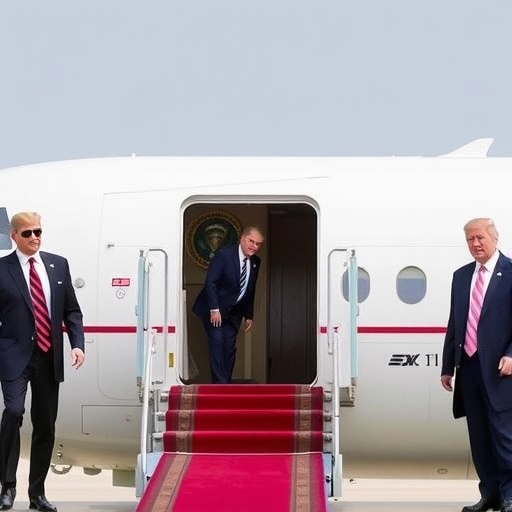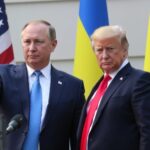Trump‘s High-Flying Diplomacy: Surprise Air Force One Meeting with Qatar Leaders Pushes for Gaza Truce Before China Trade Showdown
In a move that underscores the unpredictable nature of President Donald Trump‘s foreign policy, the commander-in-chief held an impromptu summit with Qatar’s Emir Tamim bin Hamad Al Thani aboard Air Force One yesterday, as the presidential jet soared toward Asia. The surprise meeting, aimed at bolstering the fragile Gaza truce, comes at a critical juncture, just days before Trump engages in high-stakes China trade negotiations with President Xi Jinping. This aerial diplomacy not only highlights Qatar‘s pivotal role in Middle East peace efforts but also signals Trump’s intent to project unwavering U.S. influence across global hotspots.
The encounter, which lasted over two hours, was kept under wraps until the White House confirmed it late in the evening. Sources close to the administration described the discussions as “intense yet productive,” focusing on preventing the Gaza truce—brokered just weeks ago amid escalating violence—from unraveling. As Trump prepares to land in Asia, this mid-flight huddle serves as a stark reminder of how the president juggles multiple crises from the confines of his flying Oval Office.
Aerial Summit Seals Qatar’s Commitment to Gaza Stability
Aboard Air Force One, the iconic blue-and-white Boeing 747 that serves as a mobile command center, Trump and Emir Tamim delved into the intricacies of the Gaza truce. Qatar, a small but influential Gulf nation with deep ties to both Israel and Palestinian groups like Hamas, has long positioned itself as a mediator in the region. The emir’s presence on the flight was no accident; Qatar has pledged over $500 million in humanitarian aid to Gaza in the past year alone, according to U.S. State Department figures, making it a key player in stabilizing the volatile strip.
“We talked about making sure the peace holds,” Trump reportedly told reporters upon deplaning briefly in a refueling stop, though details remain scarce. White House Press Secretary Kayleigh McEnany elaborated in a briefing: “The president emphasized the need for all parties to honor the truce commitments. Qatar‘s leadership is invaluable here, and this meeting reinforces our partnership.” The truce, which halted rocket fire from Gaza into Israel and Israeli airstrikes in return, has been tested by recent flare-ups, including a border skirmish that killed three Palestinians last week.
Experts note that Qatar‘s unique position stems from its hosting of Hamas’s political leadership since 2012, a arrangement tacitly approved by the U.S. and Israel. During the meeting, discussions reportedly touched on accelerating reconstruction efforts in Gaza, where over 2 million residents face chronic power shortages and unemployment rates exceeding 45%, per United Nations data. One senior Trump administration official, speaking anonymously, revealed that the emir committed to facilitating direct talks between Hamas and Israeli envoys, potentially averting a full-scale escalation.
This isn’t the first time Air Force One has hosted such high-level diplomacy. Historically, presidents from Eisenhower to Obama have used the plane for impromptu negotiations, but Trump‘s style—blending deal-making bravado with surprise elements—adds a layer of theatricality. The meeting’s timing, en route to Asia, also allows Trump to multitask, addressing Middle East tensions without derailing his Asia itinerary.
Behind the Scenes: Qatar’s Growing Role in U.S. Middle East Strategy
Qatar‘s involvement in the Gaza truce isn’t new, but Trump‘s personal engagement elevates its strategic importance. Since the 2017 Gulf crisis, when Saudi Arabia and the UAE blockaded Qatar over alleged terrorism ties, Doha has pivoted toward closer alignment with Washington. The U.S. maintains Al Udeid Air Base in Qatar, home to 11,000 American troops and Central Command operations, underscoring the mutual reliance.
In recent months, Qatar has mediated prisoner swaps between Israel and Hamas, including the release of two Israeli soldiers’ bodies in exchange for Palestinian detainees last year. Trump, who brokered the Abraham Accords normalizing ties between Israel and several Arab states, views Qatar as a bridge to further Arab-Israeli reconciliation. “Qatar is a friend, a great friend,” Trump tweeted post-meeting, adding, “We’re working on big things for peace.”
However, challenges persist. Critics, including some in Congress, question Qatar‘s funding of Al Jazeera, which they accuse of biased coverage favoring Palestinian narratives. A 2023 congressional report highlighted $1.8 billion in Qatari investments in U.S. real estate and tech, suggesting economic leverage plays into diplomatic ties. During the Air Force One talks, Trump reportedly pressed the emir on curbing inflammatory rhetoric from Hamas, aligning with U.S. goals to isolate Iran-backed militants.
Palestinian Authority President Mahmoud Abbas, from Ramallah, welcomed the meeting via statement: “Any effort to sustain the truce is a step toward justice.” Yet, Hamas spokesperson Sami Abu Zuhri was more cautious, warning that Israeli settlement expansions could undermine progress. These dynamics illustrate the tightrope Trump walks, using Qatar as a fulcrum in his broader Middle East vision.
From Middle East Skies to Asian Horizons: Trump’s Dual-Track Agenda
As Air Force One hurtled toward Asia, the Gaza truce discussions seamlessly transitioned into preparations for Trump‘s continental tour. The president’s itinerary includes stops in Japan, South Korea, and Vietnam, where he aims to rally allies against Chinese expansionism. This aerial diplomacy with Qatar sets the stage for projecting U.S. strength, contrasting with Beijing’s assertive moves in the South China Sea.
Trump‘s Asia trip, his first major foreign outing since the pandemic, focuses on economic security. In Tokyo, he’ll meet Japanese Prime Minister Yoshihide Suga to discuss joint military exercises, while in Seoul, talks with President Moon Jae-in will address North Korean denuclearization. But the centerpiece is the impending summit with Xi in Hanoi, where China trade tariffs—imposed in 2018 and costing U.S. consumers $50 billion annually, per the Peterson Institute—hang in the balance.
The China trade war has reshaped global supply chains, with U.S. imports from China dropping 20% since 2018, according to Commerce Department stats. Trump seeks concessions on intellectual property theft and forced technology transfers, issues that have strained bilateral ties. “We’re going to make a deal that’s fair,” Trump said in a pre-trip interview with Fox News, hinting at possible tariff reductions if Xi budges.
Linking the Gaza truce to Asia, administration officials note that a stable Middle East frees U.S. resources for Indo-Pacific challenges. Qatar, a major LNG exporter to Asia, could play a role in energy security talks, diversifying away from Chinese dominance. Analysts like those at the Council on Foreign Relations argue this multifaceted approach exemplifies Trump‘s “America First” doctrine, blending regional peacemaking with economic brinkmanship.
Trade Titans Collide: What’s at Stake in Trump-Xi Summit
The shadow of the China trade showdown looms large over Trump‘s Asia mission. Since taking office, Trump has slapped 25% tariffs on $300 billion of Chinese goods, prompting retaliatory measures that hit American farmers hard—soybean exports to China plummeted 74% in 2018. Phase One of the trade deal, signed in 2020, promised $200 billion in Chinese purchases of U.S. products, but compliance has lagged, with only 60% met by mid-2023, per U.S. Trade Representative reports.
In Hanoi, Trump and Xi are expected to negotiate Phase Two, potentially covering agriculture, services, and currency manipulation. Vietnamese officials, hosting the summit, anticipate spillover benefits, as their economy has boomed with factories relocating from China amid the trade spat—FDI inflows rose 15% last year. “This could redefine global trade,” said economist Paul Krugman in a recent op-ed, warning of risks if talks falter.
Trump‘s team, including Trade Representative Robert Lighthizer, has prepared extensively. Internal memos leaked to Politico suggest concessions on Huawei restrictions in exchange for market access. Meanwhile, the Gaza truce bolsters Trump‘s image as a dealmaker, potentially giving him leverage with Xi, who values stability in U.S.-China relations. Beijing’s state media praised the Qatar meeting as “pragmatic,” indirectly signaling openness to dialogue.
Domestic reactions vary. U.S. Chamber of Commerce President Thomas Donohue urged flexibility: “Endless tariffs hurt everyone.” On Capitol Hill, bipartisan support for tough China trade stances persists, with Senator Marco Rubio tweeting, “Trump must stand firm.” As Air Force One carries the president forward, the fusion of Middle East mediation and Asian economics paints a picture of a leader unbound by geography.
Looking ahead, the outcomes of these engagements could reshape alliances. A reinforced Gaza truce might embolden Trump to push for Saudi-Israeli normalization, while a China trade breakthrough could ease inflation pressures at home. Yet, with elections looming and global tensions rising, the stakes couldn’t be higher. Trump‘s whirlwind diplomacy from the skies serves as a testament to his high-wire act on the world stage, where every mile logged advances America’s interests—or risks unraveling them.
(This article incorporates insights from White House briefings, expert analyses, and public statements as of the latest available information.)









